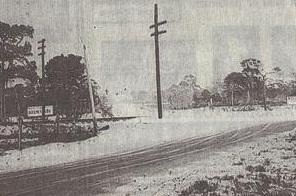Originally posted January 12, 2011.
While adding articles to the archive this morning, I came across something interesting in the Palm Beach Post. The featured photo in that particular issue is one of Park Avenue in Lake Park, looking over the railroad tracks from Dixie Highway. Here’s what that same area looked like in 1921:

According to the newspaper article, a sign reads “Kelsey City,” which is what Lake Park was called before it was renamed in 1939. The contrast is, of course, staggering:

“Back then” is a common phrase, but in actuality, this was only yesterday. In the broad spectrum, this area is quite young, and–let’s face it–the 1920s wasn’t that long ago.
The land boom hit in the twenties. Harry Seymour Kelsey came to Palm Beach to recover from an illness; the visit sparked his interest in South Florida land development. In 1919, he started buying land, purchasing 44,000 acres. He owned the areas that would one day become Palm Beach Gardens, Lake Park and our very own North Palm Beach.
Mr. Kelsey had a vision for his city; the vision didn’t include tourism. Planning began for recreation areas, homes and industrial zones. Kelsey City would be for workers; it was not meant to attract tourists, but rather those who wished to remain there with their families.
In an article entitled “Florida’s Boom, Bust Made Harry Kelsey a Survivor,” an older resident talks about all the things that Kelsey City had to offer. There were banks, theaters, parks, auto showrooms, an ice-cream plant, and a particularly successful lumberyard.
The land boom continued, but all things must end. Some things were planned, but never came to fruition.
A community was to be built near Hobe Sound, entitled Picture City. One could say that the planners had their sights set too high–the community was to include a “motion picture studio” that would have cost one million to construct.
Did it happen? Well, according to an article I found in the archives, a water tank came of it, and you won’t know where it was supposed to be unless you manage to locate a few old lampposts on the west side of SR A1A. The article itself is dated 1984, so who knows–those lampposts might not even be there anymore.
Kelsey had plans for a waterway after purchasing the Florida East Coast Canal, but his plans fell apart during the bust. Not only that, Kelsey fell into financial problems and ended up in deep trouble because of tax issues. However, he still managed to stay afloat.
Then came the 1928 hurricane, and the damages to Kelsey City were exorbitant. The town’s most prosperous times were over. Kelsey had to sell most of his original holdings. The man who bought them was Sir Harry Oakes, who at one time lived with his family at the old country club in North Palm Beach, once a part of Kelsey’s estate.
It’s amazing how things change so quickly. Next time you’re driving down Northlake Blvd., remember how young the street is, that there was a time when it wasn’t there at all.
I know that next time I’m on my way to school in West Palm Beach, and I cross the railroad tracks and head onto Dixie Highway, I’ll be thinking about the dirt road I saw in that photograph, and how it was only “yesterday” that Lake Park was Kelsey City, and everything was an entirely different world.
